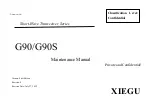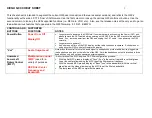
Drawing Number: 21210
Revision: NR
AN IMPROVED TECHNIQUE FOR
UTILIZATION OF CONFORMAL BALLISTICS
SENSOR CALIBRATION DATA
1
The PCB Series 117B Conformal Ballistics Sensor
(patented) measures chamber pressure in a novel
manner.
The sensitive surface of the sensor, when properly
installed in the gun chamber, conforms
or blends in
precisely with the inside surface of the chamber actually
forming a portion of the wall adjacent to the cartridge
case.
When the round is fired, the pressure builds up rapidly
inside the case, obturating the case outward against the
chamber. The force, transmitted through the thin
cartridge case wall stresses the sensor crystals producing
an output charge analogous to chamber pressure.
An exclusive calibration technique has been developed
in conjunction with the conformal sensor, consisting of a
simulated gun chamber which positions the sensor at the
same location as in the test barrel and provides for
hydraulic pressurizations of an actual cartridge case.
Using this system and a reference standard pressure
source, a point by point calibration is performed on
samples of the actual lot of ammunition under test to
take into account transmissibility characteristics of the
cartridge case for each lot of ammunition.
Because a certain amount of pressure is required to fully
obturate the cartridge case in the test chamber, a rather
severe non-linearity is exhibited over the first several
thousand psi of input pressure, i.e. until the cartridge
case is pressed firmly against the inside chamber walls.
Figure 1 illustrates a typical calibration result with .22
caliber rimfire ammunition.
Figure 1: Typical calibration graph
Conformal sensor with .22 caliber rimfire.
As shown in figure
1,
the best straight line that can be
drawn through the majority of the data points in the
linear portion of the curve, does not pass through the
origin.
Because of this, the widely accepted zero based best
straight line method of linearity determination cannot be
applied to the conformal sensor. Also, the actual
sensitivity of this sensor may only be specified at one
input pressure level since the sensitivity is not a
constant, but varies with input pressure level.
This paper outlines a simple alternative approach to
utilization of conformal sensor data.
The most universally accepted method of defining
conventional sensor nonlinearity is the full scale error
band method used in conjunction with the zero based
best straight line.





































